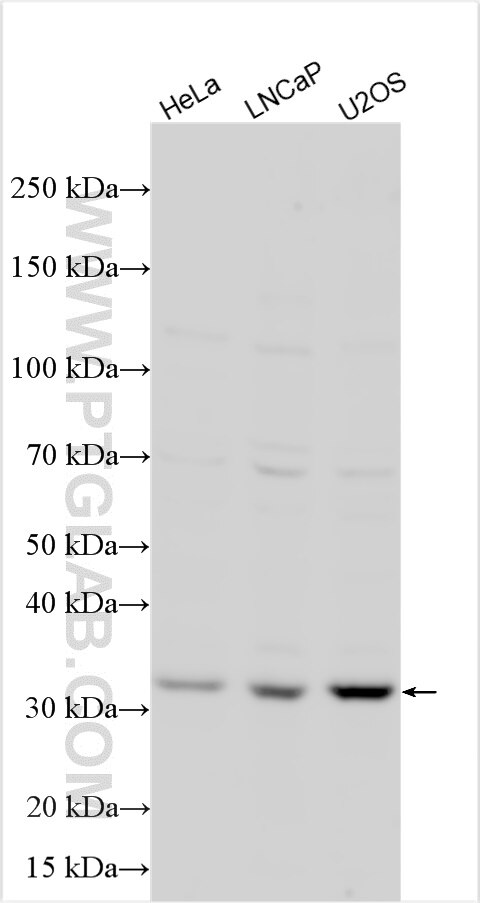Tested Applications
| Positive WB detected in | HeLa cells, LNCaP cells, U2OS cells |
Recommended dilution
| Application | Dilution |
|---|---|
| Western Blot (WB) | WB : 1:500-1:1000 |
| It is recommended that this reagent should be titrated in each testing system to obtain optimal results. | |
| Sample-dependent, Check data in validation data gallery. | |
Product Information
20336-1-AP targets BTG3 in WB, ELISA applications and shows reactivity with human samples.
| Tested Reactivity | human |
| Host / Isotype | Rabbit / IgG |
| Class | Polyclonal |
| Type | Antibody |
| Immunogen |
CatNo: Ag14112 Product name: Recombinant human BTG3 protein Source: e coli.-derived, PGEX-4T Tag: GST Domain: 97-296 aa of BC011957 Sequence: DPCEVCCRRDGVSPCWPDCSQTPDLVIRPPWPPKALDYRREPLRPASSFLIMYGEKNNAFIVASFENKDENKDEISRKVTRALDKVTSDYHSGSSSSDEETSKEMEVKPSSVTAAASPVYQISELIFPPLPMWHPLPRKKPGMYRGNGHQNHYPPPVPFGYPNQGRKNKPYRPIPVTWVPPPGMHCDRNHWINPHMLAPH Predict reactive species |
| Full Name | BTG family, member 3 |
| Calculated Molecular Weight | 296 aa, 34 kDa |
| Observed Molecular Weight | 34 kDa |
| GenBank Accession Number | BC011957 |
| Gene Symbol | BTG3 |
| Gene ID (NCBI) | 10950 |
| Conjugate | Unconjugated |
| Form | Liquid |
| Purification Method | Antigen affinity purification |
| UNIPROT ID | Q14201 |
| Storage Buffer | PBS with 0.02% sodium azide and 50% glycerol, pH 7.3. |
| Storage Conditions | Store at -20°C. Stable for one year after shipment. Aliquoting is unnecessary for -20oC storage. 20ul sizes contain 0.1% BSA. |
Background Information
BTG3 (B-cell translocation gene 3) is a member of the antiproliferative BTG/Tob gene family, which also includes BTG1, BTG2, BTG4, TOB, and TOB2. This gene family is characterized by similar N-terminal domains but divergent C-termini. BTG3 is considered a candidate tumor suppressor gene and plays a crucial role in various cellular processes, including cell proliferation, differentiation, and apoptosis. (PMID: 38714880)
Protocols
| Product Specific Protocols | |
|---|---|
| WB protocol for BTG3 antibody 20336-1-AP | Download protocol |
| Standard Protocols | |
|---|---|
| Click here to view our Standard Protocols |




